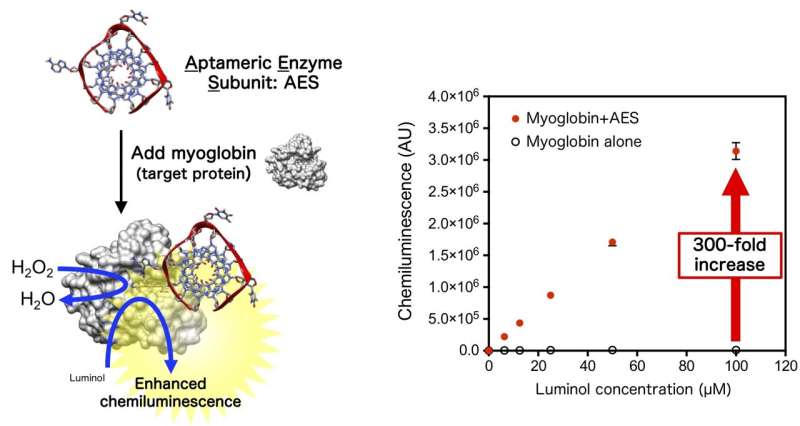G-quadruplex-forming DNA molecules enhance enzymatic activity of myoglobin

A collaboration led by Distinguished Professor Dr. Kazunori Ikebukuro from Tokyo University of Agriculture and Technology (TUAT), Japan, discovered that G-quadruplex (G4)-forming DNA binds myoglobin through a parallel-type G4 structure. Through the G4 binding, the enzymatic activity of myoglobin increases over 300-fold compared to that of myoglobin alone. This finding indicates that DNA may work as a carrier of genetic information in living organisms and act as a regulator of unknown biological phenomena.
Aptamers are nucleic acid-based synthetic ligands that can be used against many target molecules with high affinity and specificity. Some aptamers that bind to proteins are reported as specific ligands and biological function regulators. Dr. Ikebukuro and his group have developed many DNA aptamers that bind proteins, especially enzymes. In addition, they developed the aptameric enzyme modulator Aptameric Enzyme Subunit (AES), which can inhibit enzymatic activities. The current challenge for the group is to create novel aptamers that upregulate the catalytic activity of enzymes.
The collaborative team of TUAT, Riken (Japan), Denso Corporation (Japan), and the University of North Carolina, Chapel Hill (U.S.) succeeded in developing a new AES that increases the peroxidase activity of myoglobin. As myoglobin contains a heme as a cofactor, the research team found that a region near the heme-binding site can be positively charged. "We hypothesized that this region is likely to interact with negative charges of the DNA oligonucleotides derived from its sugar-phosphate backbone, which may lead to an enhancing effect on the enzymatic activity," said Dr. Ikebukuro.
The chemiluminescence measurements in their study showed that the AES specifically enhanced the peroxidase activity of myoglobin by up to 300-fold compared to that of myoglobin alone. Further, the AES bound to myoglobin strongly at the heme in myoglobin, as expected. The structural analyses by NMR and spectroscopic observation revealed the AES folded into a parallel-type G-quadruplex structure.
"Our study has revealed that DNA can potentially work as a regulator of protein's functions in the cell. On the other hand, because the AES produces a dramatically enhanced chemiluminescent signal, it could also offer a new strategy for future biosensor application studies," Dr. Ikebukuro added.
More information: Kaori Tsukakoshi et al, G-quadruplex-forming aptamer enhances the peroxidase activity of myoglobin against luminol, Nucleic Acids Research (2021). DOI: 10.1093/nar/gkab388
Journal information: Nucleic Acids Research
Provided by Tokyo University of Agriculture and Technology





















